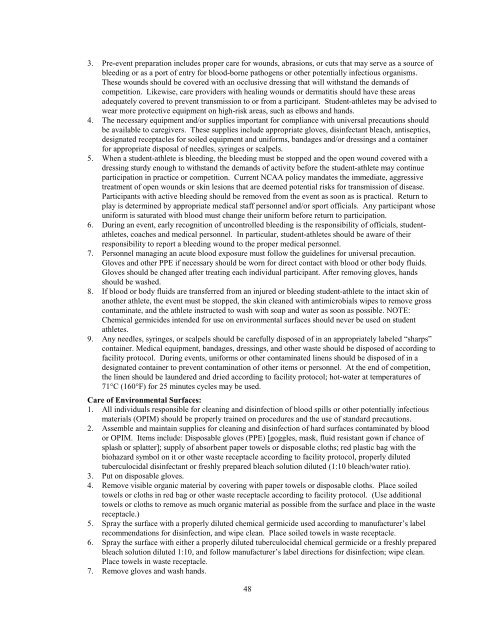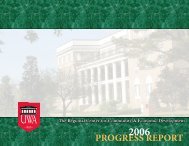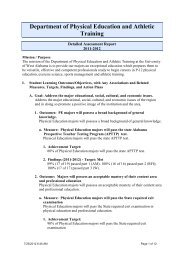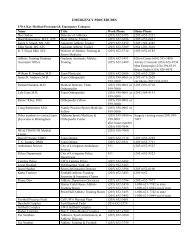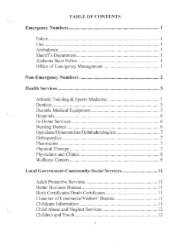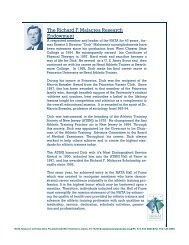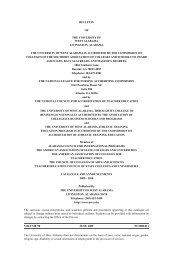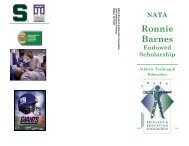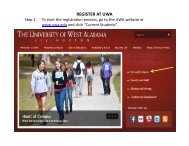table of contents - UWA Athletic Training & Sports Medicine Center
table of contents - UWA Athletic Training & Sports Medicine Center
table of contents - UWA Athletic Training & Sports Medicine Center
You also want an ePaper? Increase the reach of your titles
YUMPU automatically turns print PDFs into web optimized ePapers that Google loves.
3. Pre-event preparation includes proper care for wounds, abrasions, or cuts that may serve as a source <strong>of</strong>bleeding or as a port <strong>of</strong> entry for blood-borne pathogens or other potentially infectious organisms.These wounds should be covered with an occlusive dressing that will withstand the demands <strong>of</strong>competition. Likewise, care providers with healing wounds or dermatitis should have these areasadequately covered to prevent transmission to or from a participant. Student-athletes may be advised towear more protective equipment on high-risk areas, such as elbows and hands.4. The necessary equipment and/or supplies important for compliance with universal precautions shouldbe available to caregivers. These supplies include appropriate gloves, disinfectant bleach, antiseptics,designated receptacles for soiled equipment and uniforms, bandages and/or dressings and a containerfor appropriate disposal <strong>of</strong> needles, syringes or scalpels.5. When a student-athlete is bleeding, the bleeding must be stopped and the open wound covered with adressing sturdy enough to withstand the demands <strong>of</strong> activity before the student-athlete may continueparticipation in practice or competition. Current NCAA policy mandates the immediate, aggressivetreatment <strong>of</strong> open wounds or skin lesions that are deemed potential risks for transmission <strong>of</strong> disease.Participants with active bleeding should be removed from the event as soon as is practical. Return toplay is determined by appropriate medical staff personnel and/or sport <strong>of</strong>ficials. Any participant whoseuniform is saturated with blood must change their uniform before return to participation.6. During an event, early recognition <strong>of</strong> uncontrolled bleeding is the responsibility <strong>of</strong> <strong>of</strong>ficials, studentathletes,coaches and medical personnel. In particular, student-athletes should be aware <strong>of</strong> theirresponsibility to report a bleeding wound to the proper medical personnel.7. Personnel managing an acute blood exposure must follow the guidelines for universal precaution.Gloves and other PPE if necessary should be worn for direct contact with blood or other body fluids.Gloves should be changed after treating each individual participant. After removing gloves, handsshould be washed.8. If blood or body fluids are transferred from an injured or bleeding student-athlete to the intact skin <strong>of</strong>another athlete, the event must be stopped, the skin cleaned with antimicrobials wipes to remove grosscontaminate, and the athlete instructed to wash with soap and water as soon as possible. NOTE:Chemical germicides intended for use on environmental surfaces should never be used on studentathletes.9. Any needles, syringes, or scalpels should be carefully disposed <strong>of</strong> in an appropriately labeled “sharps”container. Medical equipment, bandages, dressings, and other waste should be disposed <strong>of</strong> according t<strong>of</strong>acility protocol. During events, uniforms or other contaminated linens should be disposed <strong>of</strong> in adesignated container to prevent contamination <strong>of</strong> other items or personnel. At the end <strong>of</strong> competition,the linen should be laundered and dried according to facility protocol; hot-water at temperatures <strong>of</strong>71°C (160°F) for 25 minutes cycles may be used.Care <strong>of</strong> Environmental Surfaces:1. All individuals responsible for cleaning and disinfection <strong>of</strong> blood spills or other potentially infectiousmaterials (OPIM) should be properly trained on procedures and the use <strong>of</strong> standard precautions.2. Assemble and maintain supplies for cleaning and disinfection <strong>of</strong> hard surfaces contaminated by bloodor OPIM. Items include: Disposable gloves (PPE) [goggles, mask, fluid resistant gown if chance <strong>of</strong>splash or splatter]; supply <strong>of</strong> absorbent paper towels or disposable cloths; red plastic bag with thebiohazard symbol on it or other waste receptacle according to facility protocol, properly dilutedtuberculocidal disinfectant or freshly prepared bleach solution diluted (1:10 bleach/water ratio).3. Put on disposable gloves.4. Remove visible organic material by covering with paper towels or disposable cloths. Place soiledtowels or cloths in red bag or other waste receptacle according to facility protocol. (Use additionaltowels or cloths to remove as much organic material as possible from the surface and place in the wastereceptacle.)5. Spray the surface with a properly diluted chemical germicide used according to manufacturer’s labelrecommendations for disinfection, and wipe clean. Place soiled towels in waste receptacle.6. Spray the surface with either a properly diluted tuberculocidal chemical germicide or a freshly preparedbleach solution diluted 1:10, and follow manufacturer’s label directions for disinfection; wipe clean.Place towels in waste receptacle.7. Remove gloves and wash hands.48


